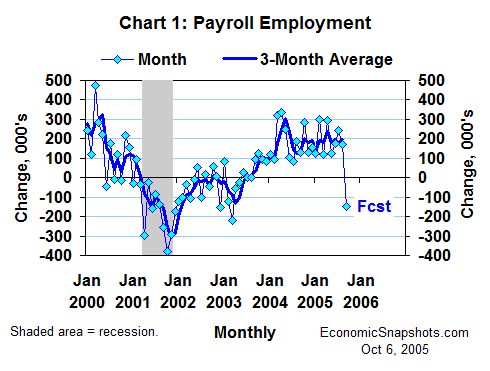
| Back to Index |
October 6, 2005 – U.S. payroll employment growth averaged a sturdy 195K per month for the 3 months through August (Chart 1). Those data were collected before Hurricane Katrina. Katrina-related disruptions in economic activity are widely expected to cause a significant decline in September payrolls (coming Friday).

The BLS said they won’t have enough information to provide an explicit estimate of Katrina-induced job losses in Friday’s employment report. They suggest looking at the regional employment data to develop an educated guess of the magnitude.
In the fourth quarter of 2004, there were 19,951 establishments and 344,436 payroll jobs in the “most heavily impacted disaster areas”. These are areas that were flooded, or suffered “severe” to “catastrophic” damage as a result of Hurricane Katrina. They include the New Orleans area and areas in and around Gulfport and Biloxi, Mississippi.
As a rule, severe weather doesn’t keep enough people away from their jobs for long enough to have much impact on payroll jobs. (To be eliminated from the payroll count, an employee must be absent from his or her job without pay for the entire pay period including the 12th of the month.) However, as the BLS points out on its website, “the extent of the destruction over a large geographic area and near total evacuation of a major U.S. city are unprecedented”. Nevertheless, beyond the “most heavily impacted disaster areas”, the regular rules (minimal payroll effects) will probably continue to apply.
Thus, a reduction of about 344K payroll jobs (essentially all of the jobs in the “most heavily impacted disaster areas”) seems to qualify as a reasonable worst-case guess for September hurricane effects. Assuming a steady underlying trend of about 195K new payroll jobs per month, this would yield a September payroll decline of about 150K (195K – 344K = –149K). Many of these job losses should be temporary, implying that we should see some extra strong payroll growth on the rebound.
Adding to the uncertainty in the September data, the “most heavily impacted disaster areas” were still very unsettled when the September employment surveys were conducted, and are expected to show exceptionally low survey response rates.
In addition, the BLS will adopt the special operating assumption that all non-responding establishments located in these areas have ceased operation and reduced their payrolls to zero. Thus, the September data will tend to overstate any negative Katrina effects in these areas. The BLS argues that this is more reasonable than their regular approach, which would have assumed that these firms were hiring at the same rate as an average firm outside of the hurricane-ravaged areas.
Suzanne Rizzo